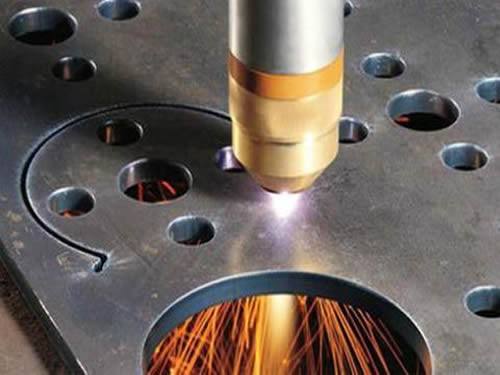
Drilling applications account for about 5% of the total laser material processing application market.The productivity gains have led to several drilling strategies related to lasers (hot and ablative drilling), beam processing, spectrophotometry, and workpiece processing, all of which have contributed to overall process efficiency and productivity gains.
Applications requiring perforation include cooling holes in jet engines or gas turbines, lubrication holes in powertrain components, injection nozzle holes, air bearing and shower nozzle holes, etc.There are also holes in strainers, screens and powertrain separators, facilities for food and chemicals, and vents in castings.
Blind holes are used in surgical needles and in the pre-cut stage used to segment fragile materials, which is now standard in the fabrication of connecting rods, bearings and ceramics, as well as sapphire substrates.Other applications include oil-storage pits or medical implants for surface lubrication, and emerging markets for contact processing of crystalline solar cells or semiconductors.In this paper, the diameter of the through-hole is between 0.01 and 1.5mm, and the depth-diameter ratio between depth and diameter is between 1 and 30.Depending on the application, the holes have different geometric shapes, ranging from cylinders to cones, grooves, or specific shapes.
The main task facing today is to combine high productivity with the growing demand for higher geometric tolerances, while reducing side effects in processing.The appropriate technology and strategy can be derived in part from Figure 1(a) and Figure 1(b).It is clear from these Numbers that there are application areas where very few holes are drilled per workpiece and the drilling time is very short, which is quite challenging from a systems engineering perspective to feed and position.On the other hand, it is necessary to adopt an effective drilling strategy in time-consuming hole processing with high depth-diameter ratio, because hundreds of holes are drilled in each workpiece.
Industrial laser drilling can be divided into monopulse or punch, punch or spiral punch.Pulsed solid-state lasers or modulated/pulsed fiber lasers are used in these applications with pulse intervals usually between microseconds (thermal pulses) and picoseconds (non-thermal pulses).As a rule, holes with lower quality requirements and higher depth-diameter ratios are usually processed using heat pulses.A lamp-pumped laser can provide such pulses with a typical pulse repetition rate below 5kHz.High quality holes can be machined by short pulse laser with a repetition frequency of more than 100kHz.

High-speed, layer-by-layer "loop" perforation has become increasingly popular with high-brightness semiconductor diodes pumping solid-state lasers or cw mode fiber lasers using advanced beam steering technologies such as fast precision rotating optical elements or oscillators for processing thin materials of less than 1mm thickness.But these perforations will not be discussed in detail in this article.
For all hot punching processes, productivity must compromise quality, especially in the case of possible side effects of heat effects (such as recasting and microcracking).The effects of pulse shape and pulse modulation on perforation efficiency and quality have been investigated.The results of these surveys clearly show that there is room for improvement in hot punching.
Monopulse punching
Holes with diameters between 0.015 and 1.2mm can be machined using a lamp pumped pulse industrial Nd:YAG solid-state laser with a M2 value between 3 and 60.Figure 2 shows a qualitative range diagram, given productivity as a function of the depth-diameter ratio and aperture.When the depth-diameter ratio is 10, it has been marked in the figure.The productivity limit of the high frequency power laser is indicated by the existing pulse repetition frequency.Illustration (a) in Figure 2 shows a 0.5mm thick stainless steel vehicle filter with up to 1200 holes of 0.05mm diameter.The holes are machined in 2 seconds.This productivity is achieved on the premise of a rapidly rotating shaft and other auxiliary means (such as brackets) to achieve repeated hole machining geometric accuracy and avoid burrs.Illustration (b) is a stainless steel coffee machine part with a hole diameter of 0.25mm (depth-diameter ratio of 2.5), drilled at a rate of 30 holes per second.Illustration (c) shows a piston ring with 0.7mm diameter holes machined at 30 holes per second using a 500 watt (pulsed peak power of 30kW) laser.Typical tolerances range from 5% to 10%.
● High quality AKJ1530 CO2 laser cutting machine
● ATC CNC Router with a horizontal spindle
● High quality AK30F fiber laser marking machine
● High quality AK20F laser fiber marking machine
● Big news: we're building a new factory
● Polish customer purchased AKM1530 high quality CNC engraving machine
● Heavy duty ATC CNC router with horizontal spindle AKM2030C
● Acctek exhibition footprint
● Cost-effective fiber laser cutting machine AKJ1530F1
● ACCTEK cnc router wishes everyone a Merry Christmas
Get a Free Quote Now!
Useful Link
Recommend Machine
Big discount

Headquarters: 3-1007, Minghu Plaza, No. 777 Minghu West Street,Jinan City / Branch: A2-1-1802, Hanyu Jingu, High-tech Zone, Jinan City
Factory: No. 3 Zone A, Lunzhen Industrial Zone,Yucheng City , Shandong Province
Copyright © Jinan AccTek Machinery Co.,Ltd